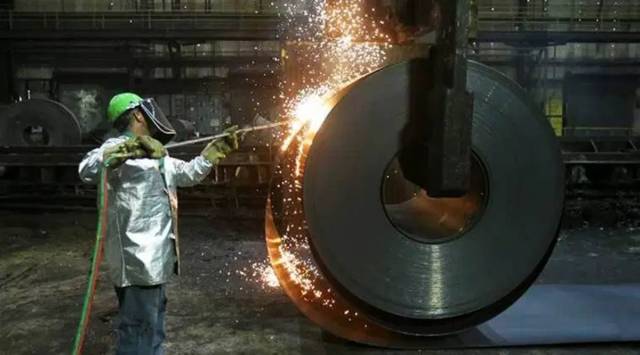Industrial output hits 26-month low, retail inflation silver lining
Data released separately by NSO showed the retail inflation rate had slipped to an 11-month low of 5.88 per cent in November, falling below the upper level of the 4+/- 2 per cent target of the Reserve Bank of India (RBI), for the first time in 11 months due to easing food prices.
 Manufacturing output, which accounts for 77.6 per cent of the weight of the IIP, contracted 5.6 per cent in October as against 3.3 per cent growth in the previous year. (File Photo)
Manufacturing output, which accounts for 77.6 per cent of the weight of the IIP, contracted 5.6 per cent in October as against 3.3 per cent growth in the previous year. (File Photo) INDUSTRIAL OUTPUT, as measured by the Index of Industrial Production (IIP), slumped to a 26-month low of (-) 4 per cent in October on the back of a contraction in manufacturing and consumer goods, data released by the National Statistical Office (NSO) showed — indicating weak exports and sluggish consumption demand, alongside the continuing weakness of small and medium enterprises.
Data released separately by NSO showed the retail inflation rate had slipped to an 11-month low of 5.88 per cent in November, falling below the upper level of the 4+/- 2 per cent target of the Reserve Bank of India (RBI), for the first time in 11 months due to easing food prices.
The downslide in exports and weak consumption demand weighed on industrial output, with the overall index value seen at 129.6, the same level as seen in October during the Covid period of 2020-21. The index was recorded at 135 in 2021-22.
Manufacturing output, which accounts for 77.6 per cent of the weight of the IIP, contracted 5.6 per cent in October as against 3.3 per cent growth in the previous year. The maximum decline in output was seen for clothing, electrical equipment, textiles, pharmaceuticals, and leather and related products, with most of these sectors having a large export share and production concentrated in the small and medium enterprises (SMEs) segment.
“Industrial output is weakening visibly, even as services sector growth is holding up quite well and keeping economic growth resilient. The IIP data indicates that the global manufacturing slowdown is also being felt in India, as negative spillovers from a slowing global economy take their toll through both the trade and financial channels,” Rahul Bajoria, MD & Head of EM Asia (ex-China) Economics, Barclays, said.
The bump-up in demand seen last year seems to be normalising even as this decline in manufacturing output is reflective of the impact on MSMEs and exports slowdown, former Chief Statistician Pronab Sen said. “It is reflective of the impact on MSMEs. So far, the recovery was seen due to higher spending by the better-off segment, which is not a growing market. So now the demand is coming down to normal levels. Manufacturing had seen a bump up and is not correcting, as was visible in the Q2 GDP data, while services sector was subdued and is now growing strongly,” Sen said.
A contraction was recorded for capital goods output — a proxy for investment sentiment — after a gap of nine months at (-) 2.3 per cent, indicating weak investment. Consumer durables and consumer non-durables output — an indicator of fast-moving consumer goods — also continued to be in negative territory at (-) 15.3 per cent and (-) 13.4 per cent, respectively, reflecting weak consumption demand, especially in rural areas.
“Capital goods has been disappointing as it indicates that investment is lagging. Negative growth comes over negative growth last year too. Clearly private sector investment has not picked up so far. Consumer goods continue to disappoint this time too as both durable and non-durable goods have witnessed de-growth. This is a let-down as one would have expected them to be buoyant during the festival month of October. Quite clearly, high nominal consumption has been due to higher inflation. Future prospects look not so positive as we move to the end of the festival months,” Madan Sabnavis, Chief Economist, Bank of Baroda, said.
Though the festival season reported strong sales of many consumer durable items, this is not reflected in the IIP numbers. “Is it due to the high base of last year? The answer is, no. Both consumer durables and non-durables had done badly even last year in the month of October. Moreover, if the post-festive season of last year is an indication, then in the coming months consumer durables and non-durables growth are again expected to disappoint,” Sunil Sinha, Principal Economist, India Ratings and Research, said.
“…another view of the dismal performance of the industrial sector can be gauged from the fact that except infrastructure and primary goods, the output level of other used-based segments is still below the pre-Covid level (Feb 2020). The output levels of all the user-based segments in the past months surpassed the pre-Covid levels though in different months, but could not hold it at that level or accelerate it. It appears that weak domestic demand in combination with waning export demand is impacting the industrial output growth,” Sinha said.
The retail inflation front witnessed a decline for the second consecutive month to 5.88 per cent in November, from 6.77 per cent in October 2022. It was 4.91 per cent in November last year. In a tweet, the Finance Ministry said the steps taken by the Government have helped in bringing down inflation below the RBI’s tolerance level. “To soften the prices of cereals, pulses and edible oils, appropriate trade-related measures have been undertaken. The impact of these measures is expected to be felt more significantly in the coming months,” the Ministry said.
Food inflation, which accounts for nearly 47 per cent of the CPI basket, eased to 4.67 per cent in November from 7.01 per cent in October while fuel inflation increased to 10.62 per cent in November from 9.93 per cent.



- 01
- 02
- 03
- 04
- 05




























